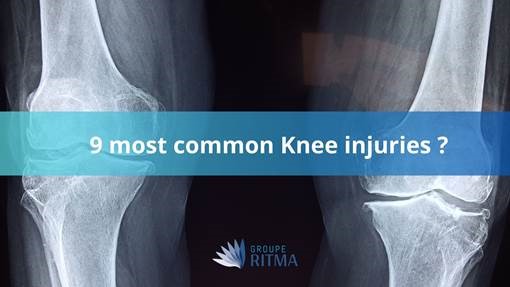
Chronicles
17 October 2023
9 Types of Knee Injuries that are Common

Osteoarthritis
Osteoarthritis is the leading cause of knee pain, primarily in older people. It occurs when the protective cartilage in the joints breaks down, causing the bones to rub together. Symptoms include stiffness, swelling and pain during movement. Treatments for osteoarthritis range from pain medications, physical therapy, and lifestyle adjustments to orthopedic aids, and in severe cases, surgery.
Knee pain resulting from hip or foot pain
Hip or foot pain may lead to gait modifications to relieve these painful areas, but this can put additional pressure on the knee joint, leading to pain.
Ligament Injuries
Ligament injuries, such as a torn anterior cruciate ligament (ACL) or a sprained medial collateral ligament (MCL), are often related to sporting activities or sudden movements. They cause severe pain, swelling, instability and limitations of movement. Treatment for ligament injuries may include rest, ice, compression, elevation (RICE), physical therapy, the use of splinting, and in severe cases, surgery.
Tendonitis
Tendonitis, or inflammation of the tendons around the knee, often affects athletes and people who perform repetitive movements. Symptoms include pain, swelling, and tenderness around the affected tendon. Treatment for tendonitis usually involves rest, ice, physical therapy, nonsteroidal anti-inflammatory drugs (NSAIDs), and sometimes corticosteroid injections.
Bursitis
Bursitis results from inflammation of the bursae, small fluid-filled sacs that cushion the joints. Knee bursitis commonly occurs due to repetitive kneeling or direct trauma. Symptoms include pain, swelling, and warmth in the affected area. Treatment options include rest, ice, compression, NSAIDs, and sometimes puncture or corticosteroid injections.
Patellofemoral Pain Syndrome
The patellofemoral pain syndrome (PFPS) is characterized by pain in the front of the knee, particularly around the kneecap. It often affects athletes, runners and people with muscle imbalances. Treatment for PFPS includes physical therapy, strengthening exercises, activity adaptations, orthotics, and sometimes orthopedic devices.
Meniscus Tears
The meniscus, a cartilaginous cushion between the femur and the tibia, can tear following sudden movements or degenerative wear. This causes pain, swelling, and limitations of movement. Treatment for meniscus tears can be conservative, with rest, ice, and physical therapy, or surgical, depending on the severity and location of the tear.
Fractures
The knee bones, including the kneecap, can fracture in falls or accidents. Sometimes fractures occur in people whose bones are weakened by osteoporosis, even with a simple misstep.
Baker's Cyst
Baker's cyst, or popliteal cyst, is a fluid-filled mass that forms at the back of the knee joint. It is often associated with underlying conditions such as arthritis, meniscal tears, or other injuries causing inflammation and synovial fluid buildup. Excess fluid creates a visible bump or swelling at the back of the knee.
When a doctor refers to an osteopath in some cases for a knee injury, the osteopath will work to reduce discomfort while removing pressure on the knee joint. The objective is to rebalance the structures of the body and restore as much flexibility as possible to the joints to facilitate movements.
https://www.hopkinsmedicine.org/health/conditions-and-diseases/knee-pain-and-problems
https://www.mayoclinic.org/diseases-conditions/knee-pain/symptoms-causes/syc-20350849
https://orthoinfo.aaos.org/en/diseases–conditions/bakers-cyst-popliteal-cyst/